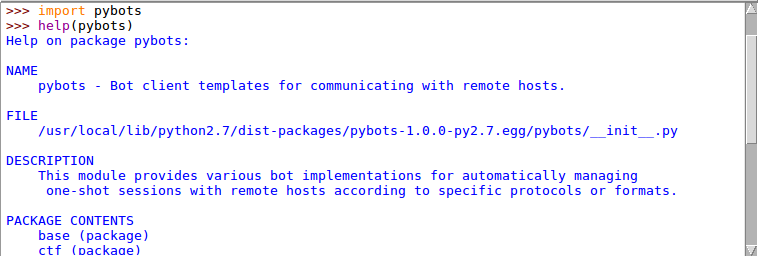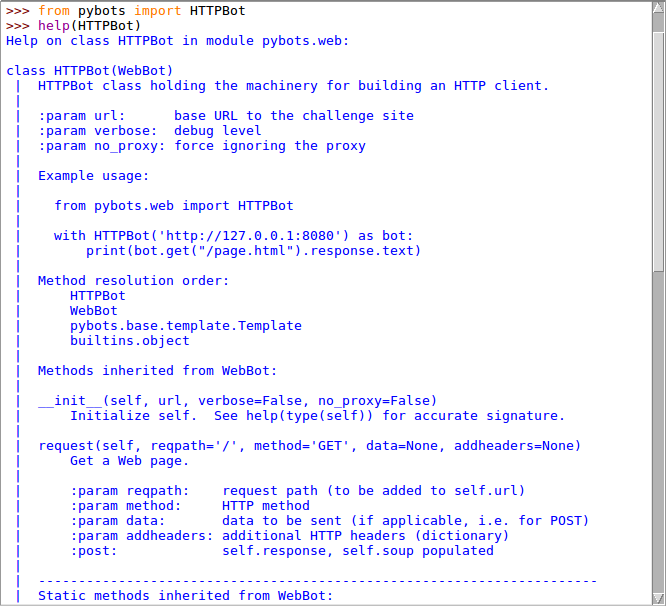Generalities
Overview¶
Each bot class is implemented as a context manager and has a basic configured logger attached. It can thus be instantiated in a clear and straightforward way. Here is an example:
from pybots import TCPBot
class MyBot(TCPBot):
def precompute(self):
self.lookup_table = ...
def preamble(self):
self.read_until('>')
with MyBot("remote_host", 1234) as bot:
bot.write("Hello!")
data = bot.read_until("hash: ")
hash = data.split("hash: ")[-1]
hash = bot.lookup_table[hash]
bot.write(hash)
Note that, if a bot is used behind a proxy, it will use system's proxy settings. This behavior can be bypassed by using no_proxy=True while instantiating the bot.
with MyBot("LAN_host", 1234, no_proxy=True) as bot:
# ...
Getting help¶
Each module is documented. Python's built-in help function can thus be used to get help from an interactive console.


Features¶
Each bot comes with the following features (in order of precedence), inherited from the template:
- Logging: A public method named
configuresets the logging level and attaches a logger to the bot. Logging can thus be reconfigured in the context of the bot. The verbose mode is a boolean and configures the bot for debugging if the value is false.
""" verbose mode example """
with Bot(..., verbose=True) as bot:
# debug messages will be displayed
# if verbose=False, logging is configured to INFO
""" logging reconfiguration example """
with Bot(...) as bot:
bot.configure(new_log_message_format, new_date_format)
Default formats
- Messages:
%(asctime)s [%(levelname)s] %(message)s - Dates:
%H:%M:%S
- System proxy settings: When the bot starts, it gets the system proxy settings to work with (
no_proxy=Falseby default). This behavior can be overridden by settingno_proxy=False.
""" no proxy example """
with Bot(..., no_proxy=True) as bot:
# the bot ignores the proxy settings
- Pre/Post-computation: By default, when a bot is initialized, it tries to execute a public method named
precomputeif it exists. This allows to perform computations BEFORE the context of the bot is entered. Similarly, when a bot comes to the end of its execution, it tries to execute a public method namedpostcomputeif it exists. This allows to perform computations AFTER bot's communication has ended, just before exiting the context.
""" precomputation example """
class MyBot(Bot):
def postcompute(self):
# perform some computation
def precompute(self):
# perform some computation
# create attributes for use in bot's context
with MyBot(...) as bot:
# use bot's precomputed attributes
# let the bot postcompute other stuffs
Default behavior
Fail-open (the bot continues if the pre/post-computation fails and provides a warning)
- Pre/Post-amble: By default, when bot's context is entered, it tries to execute a public method named
preambleif it exists. This allows to play a preamble with the remote host to keep bot's context code clean. Similarly, when a bot comes to the end of its context, it tries to execute a public method namedpostambleif it exists. This allows to perform actions before bot's communication has ended, thus before exiting the context.
""" preamble example """
class MyBot(Bot):
def postamble(self):
# play some postamble commands
def preamble(self):
# play some preamble commands
with MyBot(...) as bot:
# start using the bot without caring for the pre/post-amble actions
Default behavior
Fail-close (the bot crashes if the preamble fails and displays the exception with its traceback)